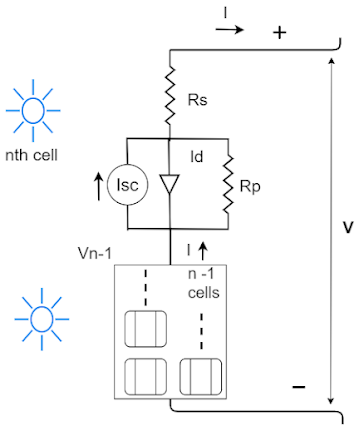Power output of the solar PV module reduces dramatically when there is shading in the solar cell. Even single shaded cell in long string causes power output by more than half. To enhance the performance of the module under partial shading condition external diodes are purposely added to the solar PV module. Adding diode, possible impact on the output I-V curve can be mitigate with least amount of power loss.
 |
| Fig.1 : All cell in Sun, no shading impact on output power |
For the better understanding of shading impact of solar cell, consider solar
PV module consist of n number of cell providing output current ( I )and voltage
( V). One cell from the string is separated and its equivalent circuit is drawn
as shown in fig. 1. In the module n-1 cells are there providing current
( I ) and voltage (Vn-1).
 |
| Fig.1 : Top cell shaded, shading impact on output power |
In fig. 2, all n-1 cell are in full sun and one top cell is shaded,
its current source Isc has been reduced to zero. Diode is reversed biased and
total current (I) has to flow from Series Resistance ( Rs ) and
shunt Resistance ( Rp ) causing high voltage drop. Instead of adding
up the output voltage, shading reduces the voltage thus has significant power
loss.
Mathematic analysis of the shading impact:
consider, bottom n-1 cells have full sun, current and voltage output are I
and Vn-1 respectively.
Total voltage output of the module with one cell shaded,
Vsh = Vn-1 -I * (Rp + Rs)
When there is n cell having full sun, I and V are the corresponding current
and voltage output.
So, voltage of bottom n-1 cell is,
Vn-1
= (n-1)*V/n
Solving i and ii,
Vsh = (n-1)*V/n - I *( Rp + Rs)
So,
∆V = V- (n-1)*V/n + I *( Rp + Rs)
= ( V/n) + I *( Rp + Rs)
Note 1: Rp can cause significant power
loss and are mainly due to manufacturing defects. For a cell to have losses of less than 1% due
to its parallel resistance, Rp should be greater than about,
Rp >
Note 2: Series resistance is due to contact resistance associated with the
bond between the cell and its wire leads, and some might be due to the resistance
of semiconductor itself. For a cell to have the series resistance, Rs
will needs to be less than about,
Rs < (0.01*Voc)/Isc
∆V = ( V/n ) + I *( Rp )
At any given current, the I –V curve for the module with one shaded cell drops by ∆V . The huge impact this can have is illustrated in Fig. 3.
 |
| Fig. 3: Effect of shading one cell in an n - cell module |
Mathematical Analysis:
Question :
The 36-cell PV module with a parallel resistance per cell of Rp = 6.6 V . In full sun and at current I = 2.14 A the output voltage was found there to be V = 19.41 V. If one cell is shaded and this current somehow stays the same, then:
a. What would be the new module output voltage and power?
b. What would be the voltage drop across the shaded cell?
c. How much power would be dissipated in the shaded cell?
Solution
a. the drop in module voltage will be
∆V = ( V/n ) + I *( Rp )
= (19.41 / 36 )+ 2.14 × 6.6
= 14.66 V
The new output voltage will be 19.41 − 14.66 = 4.75 V.
Power delivered by the module with one cell shaded would be
Pout = V * I
= 4.75 V × 2.14 A
= 10.1 W
For comparison, in full sun the module was producing 41.5 W.
b. All of that 2.14 A of current goes through the parallel plus series resistance (0.005 ohm) of the shaded cell, so the drop across the shaded cell will be
∆V = I*(Rp + Rs)
= 2.14*(6.6 + 0.005)
= 14.14 V
(normally a cell in the sun will add about 0.5 V to the module; this shaded cell subtracts over 14 V from the module).
c. The power dissipated in the shaded cell is voltage drop times current, which is
P = ∆V*I
= 14.14 V × 2.14 A
= 30.2 W
All of that power dissipated in the shaded cell is converted to heat, which can cause a local hot spot that may permanently damage the plastic laminates enclosing the cell.
YOU MAY LIKE





4 Comments
Thanks for providing the best shading analysis of solar cells manufacturing in India. More details- https://websitepetron2016.wixsite.com/website, know about the best manufacturer company based in India- Petron Thermoplast.
ReplyDeleteThank you so much for your response and information
DeleteGood article. Appreciating the time and effort you put into your website and in depth information you offer on solar cells. I would also like to recommend you to know more about best solar company in India
ReplyDeleteThank you!
Thank you so much for your response
Delete